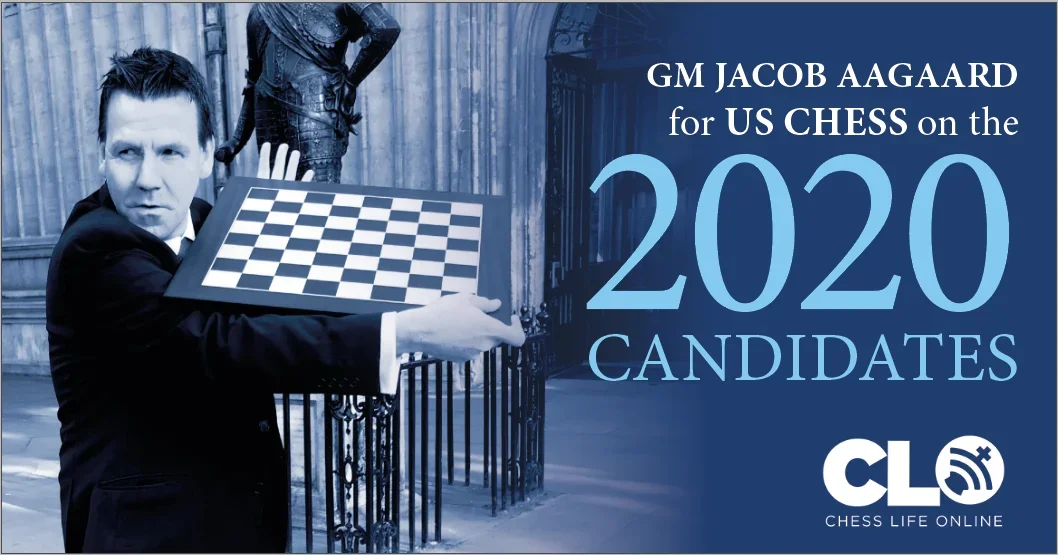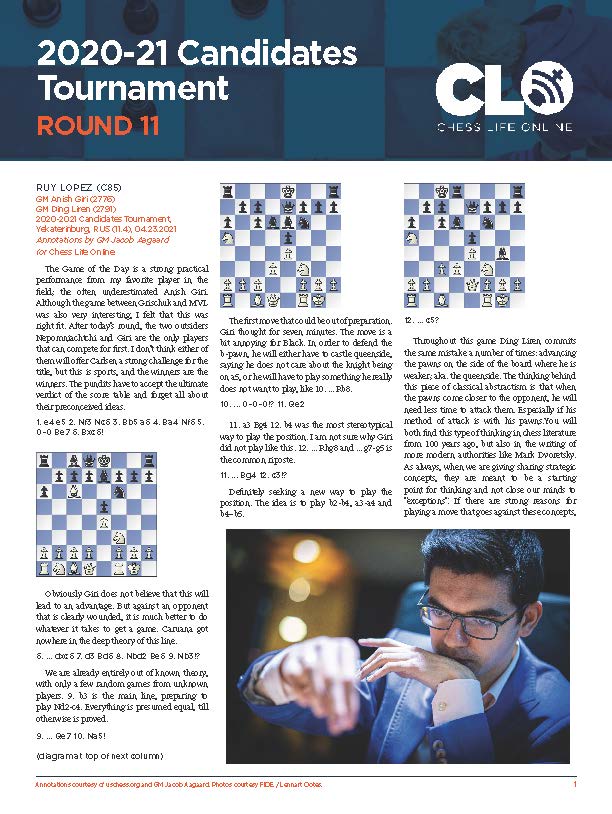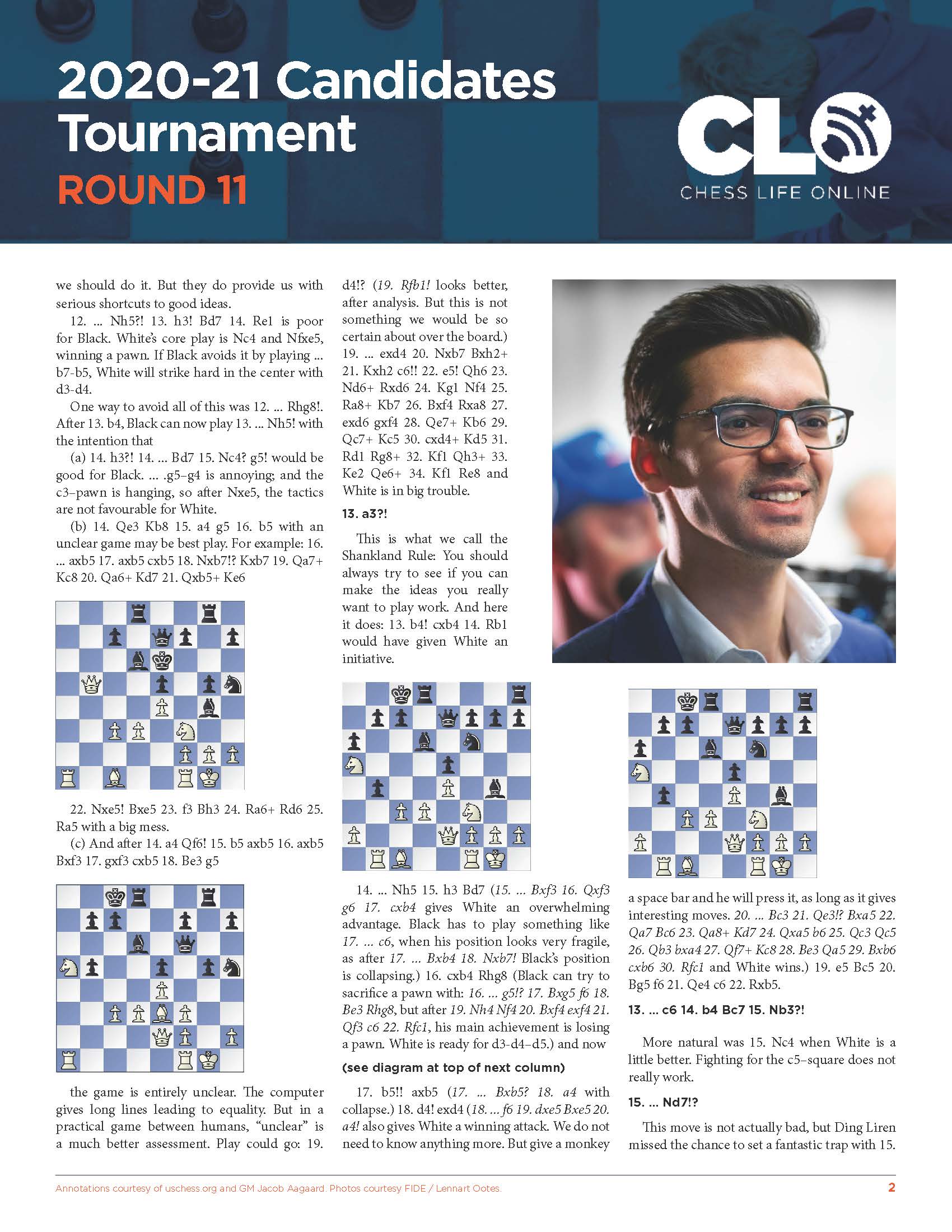For the eleventh installment of his “Candidates Game of the Day” series, GM Jacob Aagaard has analyzed GM Anish Giri's key win over GM Ding Liren as only he could – deeply, extensively, definitively. This is the analysis that the experts will be quoting tomorrow, and we have it exclusively here at Chess Life Online.

Fans of Aagaard's work may also want to check out his recap of Round 11 on the Killer Chess Training YouTube channel.
https://youtu.be/LpDePelNWHs
Below we provide Aagaard’s analysis in replayable format. For those who prefer paper, boards, and pieces, we have created a pdf version.
You can also check out an alternative replayable version posted in the ChessBase Cloud.
[pgn][Event "FIDE Candidates Tournament"] [Site "chess24.com"] [Date "2021.04.23"] [Round "11.4"] [White "Giri, Anish"] [Black "Ding, Liren"] [Result "1-0"] [ECO "C85"] [WhiteElo "2776"] [BlackElo "2791"] [Annotator "Aagaard"] [PlyCount "57"] [EventDate "2021.??.??"] [WhiteTeam "Netherlands"] [BlackTeam "China"] [WhiteTeamCountry "NED"] [BlackTeamCountry "CHN"] {[%evp 0,57,20,51,11,15,17,15,28,16,8,2,18,5,5,4,4,2,2,-7,-7,-13,-11,-13,15,-4, 19,2,15,15,11,19,39,-8,8,0,11,0,0,-36,53,18,63,69,69,82,96,21,-8,59,148,131, 144,144,144,165,238,243,693,730] The Game of the Day is a strong practical performance from my favourite player in the field; the often underestimated Anish Giri. Although the game between Grischuk and MVL was also very interesting, I felt that this was right fit. After today's round, the two outsiders Nepomniachtchi and Giri are the only players that can compete for first. I don't think either of them would be offering Carlsen a strong challenge for the title, but this is sports, and the winners are the winners. The pundits have to accept the ultimate verdict of the score table and forget all about their preconceived ideas.} 1. e4 e5 2. Nf3 Nc6 3. Bb5 a6 4. Ba4 Nf6 5. O-O Be7 6. Bxc6 $1 {[#] Obviously Giri does not believe that this will lead to an advantage. But against an opponent that is clearly wounded, it is much better to do whatever it takes to get a game. Caruana on the other hand got nowhere in the deep theory of this line.} dxc6 7. d3 Bd6 8. Nbd2 Be6 9. Nb3 $5 {We are already entirely out of known theory, with only a few random games from unknown players.} (9. b3 {is the main line, preparing to play Nc4. Everything is presumed equal, till otherwise is proved.}) 9... Qe7 10. Na5 $1 { [#] The first move that could be out of preparation. Giri thought for seven minutes. The move is a bit annoying for Black. In order to defend the b-pawn, he will either have to castle queenside, saying he does not care about the knight being on a5, or he will have to play something he really does not want to play, like 10...Rb8.} O-O-O $5 11. Qe2 (11. a3 Bg4 12. b4 {was the most stereotypical way to play the position. I am not sure why Giri did not play like this.} Rhg8 {and ...g5 is the common riposte.}) 11... Bg4 12. c3 $5 { Definitely seeking a new way to play the position. The idea is to play b4, a4 and b4-b5.} {[#]} c5 $2 {Throughout this game Ding Liren commits the same mistake a number of times: advancing the pawns on the side of the board where he is weaker; aka. the queenside. The thinking behind this piece of classical abstractism is that when the pawns come closer to the opponent, he will need less time to attack them. Especially if his method of attack is with his pawns. You will both find this type of thinking in chess literature from 100 years ago, but also in the writing of more modern authorities like Mark Dvoretsky. As always, when we are giving sharing strategic concepts, they are meant to be a starting point for thinking and not close our minds to "exceptions". If there are strong reasons for playing a move that goes against these concepts, we should do it. But they do provide us with serious shortcuts to good ideas.} (12... Nh5 $6 13. h3 $1 Bd7 14. Re1 {is poor for Black. White's core play is Nc4 and Nfxe5, winning a pawn. If Black avoids it, play B, d3-d4, will strike hard.}) (12... Rhg8 $1 {was one way to avoid all of this. After} 13. b4 { , Black can now play} Nh5 $1 {, with the intention that} 14. h3 $6 ({And after } 14. a4 Qf6 $1 15. b5 axb5 16. axb5 Bxf3 17. gxf3 cxb5 18. Be3 g5 {[#] the game is entirely unclear. The computer gives long lines leading to equality. But in a practical game between humans, "unclear" is a much better assessment. Play could go:} 19. d4 $5 exd4 20. Nxb7 Bxh2+ 21. Kxh2 {[#]} c6 $3 22. e5 $1 Qh6 23. Nd6+ Rxd6 24. Kg1 Nf4 25. Ra8+ Kb7 26. Bxf4 Rxa8 27. exd6 gxf4 28. Qe7+ Kb6 29. Qc7+ Kc5 30. cxd4+ Kd5 31. Rd1 Rg8+ 32. Kf1 Qh3+ 33. Ke2 Qe6+ 34. Kf1 Re8 {and White is in big trouble. 19.Rfb1! looks better, after analysis. But this is not something we would be so certain about over the board.}) (14. Qe3 Kb8 15. a4 g5 16. b5 {with an unclear game may be best play. For example:} axb5 17. axb5 cxb5 18. Nxb7 $5 Kxb7 19. Qa7+ Kc8 20. Qa6+ Kd7 21. Qxb5+ Ke6 {[#]} 22. Nxe5 $1 Bxe5 23. f3 Bh3 24. Ra6+ Rd6 25. Ra5 {with a big mess...}) 14... Bd7 15. Nc4 $2 g5 $1 {would be good for Black. ...g5-g4 is annoying; and the c3-pawn is hanging, so after Nxe5, the tactics are not favourable for White.}) 13. a3 $6 ({This is what we call the Shankland Rule: You should always try to see if you can make the ideas you really want to play work. And here it does:} 13. b4 $1 cxb4 14. Rb1 {would have given White an initiative. [#]} Nh5 15. h3 Bd7 (15... Bxf3 16. Qxf3 g6 17. cxb4 {Gives White an overwhelming advantage. Black has to play something like 17...c6, when his position looks very fragile, as after} Bxb4 18. Nxb7 $1 {Black's position is collapsing.}) 16. cxb4 Rhg8 ({ Black can try to sacrifice a pawn with:} 16... g5 $5 17. Bxg5 f6 18. Be3 Rhg8 { , but after} 19. Nh4 Nf4 20. Bxf4 exf4 21. Qf3 c6 22. Rfc1 {, the main thing he has achieved by it is to lose a pawn. White is ready for d4-d5.}) {[#]} 17. b5 $3 axb5 (17... Bxb5 $2 18. a4 {with collapse.}) 18. d4 $1 exd4 (18... f6 19. dxe5 Bxe5 20. a4 $1 {also gives White a winning attack. We do not need to know anything more. But give a monkey a space bar and he will press it, as long as it gives interesting moves.} Bc3 21. Qe3 $5 Bxa5 22. Qa7 {[#]} Bc6 23. Qa8+ Kd7 24. Qxa5 b6 25. Qc3 Qc5 26. Qb3 bxa4 27. Qf7+ Kc8 28. Be3 Qa5 29. Bxb6 cxb6 30. Rfc1 {and White wins.}) 19. e5 Bc5 20. Bg5 f6 21. Qe4 c6 22. Rxb5) 13... c6 14. b4 Bc7 15. Nb3 $6 (15. Nc4 {was more natural. White is a little better. Fighting for the c5-square does not really work.}) 15... Nd7 $5 {This move is not actually bad, but Ding Liren missed the chance to set a fantastic trap:} ( 15... Qd6 $3 16. Rd1 $2 {would be the first idea of many, not fearing 16...c4. But instead Black has:} ({So for this reason, best play may be:} 16. Nxc5 Nd7 17. Nb3 Nb6 $5 (17... f5 $5 {with a wild game is also feasible.}) 18. Nc5 Nd7 { with a repetition of moves.}) {[#]} 16... Nxe4 $3 17. Qxe4 f5 18. Qe3 e4 $1 { White can escape from immediate defeat with} 19. Qxc5 $1 exf3 20. Qxd6 Bxd6 { , where Black is only a little bit better. But still if would be a sad affair for White, having to defend against those powerful bishops.}) 16. h3 Bh5 17. Be3 $2 {Giri continued fighting for the c5-square and is met with a strong riposte.} (17. Re1 {or another quiet move was preferable, after which the position is quite level.}) {Only after playing his move did Giri realise that Black had ideas with ...c5-c4 and ...f7-f5.} 17... f5 $1 18. Bxc5 $1 ({White cannot play} 18. exf5 $2 {, or he will get destroyed on the light squares:} { [#]} c4 $1 19. Nbd2 cxd3 20. Qxd3 Bxf3 $1 21. gxf3 g6 $1 {and the kingside is opened in a way very unfavourable for White. He can still fight with} 22. f6 { , but it is clear that his position is bad.}) 18... Qf7 19. Rab1 g5 20. exf5 { [#]} g4 $4 {Typical of Ding's play for this tournament, whose play has been unrecognizable in this tournament. Playing this awful move after just 3 minutes is unbelievable.} (20... Qxf5 21. Qe4 {Qf6 with equality and a tiny bit more was natural. It is hard to understand what Ding missed.} (21. g4 $2 Bxg4 {won't be it. But just for clarity, we should say that after} 22. hxg4 Qxg4+ 23. Kh1 e4 $1 {Black has a winning attack.} 24. Qxe4 Qh3+ 25. Kg1 g4 26. Qf5 Rhg8 27. Ne5 {with mate of some sorts could be a fitting finish.})) 21. Ng5 Qxf5 22. h4 {[#] According to Giri, Ding simply missed this.} b6 $6 {Ding spent half an hour playing this move, provoking Giri to sacrifice a piece. It just makes his position worse; and again it is a pawn move on the side of the board where he is weaker.} ({While thinking on his move, Giri realised that he would be winning after} 22... Nf6 23. Be7 g3 24. Qe1 $1 {and all of Black's pieces are hanging.}) (22... Rhe8 23. Ne4 {also sees White dominate.}) 23. Ne4 $5 {A bold sacrifice, but probably a bit unnecessary.} ({Giri considered his opponent's move a trap, based on} 23. d4 $2 Nb8 {, when Black will accept the piece sacrifice under less clear circumstances.}) ({After} 23. Be3 {, it is hard to see what Black was planning to do. For example:} Nf6 24. d4 $1 b5 25. Nc5 {with a better position, on top of that extra pawn.}) 23... bxc5 $6 { It is hard to decline a piece sacrifice when there is nothing to be happy about with your position. But still, this is what Black had to do.} (23... g3 24. Qb2 gxf2+ 25. Rxf2 Qg4 26. Be7 (26. Na5 $6 Nb8 $1 {is not clear at all.}) 26... Rde8 27. Bd6 {White would have a real advantage, but Black would not be out of the race just yet.}) 24. bxc5 Nf6 {[#]} 25. Nd6+ $1 {Eliminating an important defender.} Bxd6 26. cxd6 Rxd6 27. d4 c5 $6 {Defending the a6-pawn, but not exactly defending the king. This pawn move in front of the king is not doing anything good for the Black position.} 28. Nxc5 Re8 {[#]} 29. Qc4 { Black resigned.} 1-0 [/pgn]
Previous "Aagaard on the Candidates" installments:
Round 1 - Giri-Nepomniachtchi
Round 2 - Caruana-Alekseenko
Round 3 - Ding Liren-Caruana
Round 4 - Vachier-Lagrave - Grischuk
Round 5 - Nepomniachtchi - Wang Hao
Round 6 - Nepomniachtchi - Ding Liren
Round 7 - Vachier-Lagrave - Nepomniatchtchi
Round 8 - Caruana - Vachier-Lagrave
Round 9 - Giri - Wang Hao
Round 10 - Nepomniachtchi - Alekseenko
Categories
Archives
- January 2026 (4)
- December 2025 (27)
- November 2025 (29)
- October 2025 (39)
- September 2025 (27)
- August 2025 (29)
- July 2025 (43)
- June 2025 (25)
- May 2025 (24)
- April 2025 (29)
- March 2025 (29)
- February 2025 (20)
- January 2025 (24)
- December 2024 (34)
- November 2024 (18)
- October 2024 (35)
- September 2024 (23)
- August 2024 (27)
- July 2024 (44)
- June 2024 (27)
- May 2024 (31)
- April 2024 (51)
- March 2024 (34)
- February 2024 (25)
- January 2024 (26)
- December 2023 (29)
- November 2023 (26)
- October 2023 (37)
- September 2023 (27)
- August 2023 (37)
- July 2023 (47)
- June 2023 (33)
- May 2023 (37)
- April 2023 (45)
- March 2023 (37)
- February 2023 (28)
- January 2023 (31)
- December 2022 (23)
- November 2022 (32)
- October 2022 (31)
- September 2022 (19)
- August 2022 (39)
- July 2022 (32)
- June 2022 (35)
- May 2022 (21)
- April 2022 (31)
- March 2022 (33)
- February 2022 (21)
- January 2022 (27)
- December 2021 (36)
- November 2021 (34)
- October 2021 (25)
- September 2021 (25)
- August 2021 (41)
- July 2021 (36)
- June 2021 (29)
- May 2021 (29)
- April 2021 (31)
- March 2021 (33)
- February 2021 (28)
- January 2021 (29)
- December 2020 (38)
- November 2020 (40)
- October 2020 (41)
- September 2020 (35)
- August 2020 (38)
- July 2020 (36)
- June 2020 (46)
- May 2020 (42)
- April 2020 (37)
- March 2020 (60)
- February 2020 (38)
- January 2020 (45)
- December 2019 (34)
- November 2019 (35)
- October 2019 (42)
- September 2019 (45)
- August 2019 (56)
- July 2019 (44)
- June 2019 (35)
- May 2019 (40)
- April 2019 (48)
- March 2019 (61)
- February 2019 (39)
- January 2019 (30)
- December 2018 (29)
- November 2018 (51)
- October 2018 (45)
- September 2018 (29)
- August 2018 (49)
- July 2018 (35)
- June 2018 (31)
- May 2018 (39)
- April 2018 (31)
- March 2018 (26)
- February 2018 (33)
- January 2018 (30)
- December 2017 (26)
- November 2017 (24)
- October 2017 (30)
- September 2017 (30)
- August 2017 (31)
- July 2017 (28)
- June 2017 (32)
- May 2017 (26)
- April 2017 (37)
- March 2017 (28)
- February 2017 (30)
- January 2017 (27)
- December 2016 (29)
- November 2016 (24)
- October 2016 (32)
- September 2016 (31)
- August 2016 (27)
- July 2016 (24)
- June 2016 (26)
- May 2016 (19)
- April 2016 (30)
- March 2016 (36)
- February 2016 (28)
- January 2016 (32)
- December 2015 (26)
- November 2015 (23)
- October 2015 (16)
- September 2015 (28)
- August 2015 (28)
- July 2015 (6)
- June 2015 (1)
- May 2015 (2)
- April 2015 (1)
- February 2015 (3)
- January 2015 (1)
- December 2014 (1)
- July 2010 (1)
- October 1991 (1)
- August 1989 (1)
- January 1988 (1)
- December 1983 (1)










